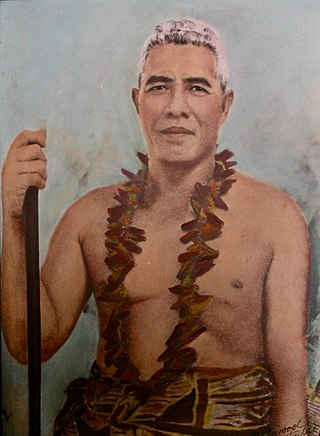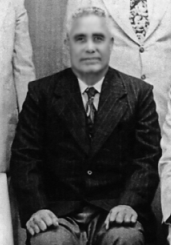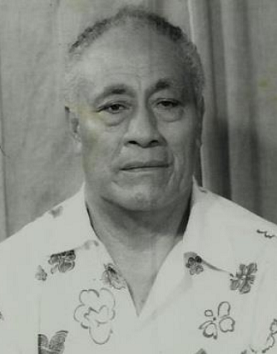 |
|---|
| Constitution |
The Fono of Faipule was a legislature in Western Samoa during the colonial era. It consisted of representatives (faipule) from each district. [1]
 |
|---|
| Constitution |
The Fono of Faipule was a legislature in Western Samoa during the colonial era. It consisted of representatives (faipule) from each district. [1]
The Fono was established in 1873 and was initially the lower house in a bicameral legislature; the Fono of Ta'imua was the upper house and consisted of the highest-ranking chiefs. [2] The legislature was abolished by the German authorities in 1905, but the Fono was subsequently reformed as an advisory body that met twice a year at Mulinu'u. [2] [3]
The Fono was legally recognised by the New Zealand authorities in 1923, [4] and was used by the Administrator to consult on Samoan affairs. [2] The faipule were nominated by chiefs in each district; if the chiefs could not agree, they were to submit two or three names to the Administrator, who would make the final decision. [2]
Following a 'Goodwill mission' to Samoa by representatives of the new Labour government of New Zealand in July 1936, the Samoans were promised the right to elect the Fono. [5] The first elections subsequently took place in September, [6] with representatives of the Mau movement winning 31 of the 39 seats. [7] The newly elected Fono met on 30 September. The members of the previous Fono (which still had 18 months of its term remaining) were also in attendance. The first session ended with the decision that members of the old Fono would resign. [7]
The new Fono requested that elections to the Fono should be formalised in legislation, abolishing the previous system of appointment. [7] As a result, the Legislative Council passed the Faipule Election Ordinance in 1939, which provided for elections to a 41-seat Fono, although voting rights were only given to matai (family heads). [7]
When the Legislative Assembly was established in 1947, the Fono was given the right to choose 11 of its 26 members, who sat alongside the Administrator, three fautau (leading chiefs), six civil servants and five elected Europeans. [8] After one of the three fautau died in 1948, the Fono successfully petitioned to increase the number of members it could nominate to 12. [9]
The Fono was abolished in 1957 by an amendment to the Samoa Act by the New Zealand government, which also increased Samoan representation in the Legislative Assembly and gave increased power to the Executive Council. [1]
The Mau was a non-violent movement for Samoan independence from colonial rule during the first half of the 20th century. Mau means ‘resolute’ or ‘resolved’ in the sense of ‘opinion’, ‘unwavering’, ‘to be decided’, or ‘testimony’; also denoting ‘firm strength’ in Samoan. The motto for the Mau were the words Samoa mo Samoa. Similarly in Hawaiian Mau means to strive or persevere, and is often linked with Hawaiian poetry relating to independence and sovereignty struggles.

The politics of Tokelau takes place within a framework of a parliamentary representative democratic dependency. The head of state of Tokelau is King Charles III in right of his Realm of New Zealand, who is represented by an Administrator. The monarch is hereditary, the Administrator is appointed by the New Zealand Minister of Foreign Affairs and Trade.

Ta'isi Olaf Frederick Nelson was a Samoan businessman and politician. He was one of the founding leaders of the anti-colonial Mau movement.

The American Samoa Fono is the territorial legislature of American Samoa. Like most states and territorial legislatures of the United States, it is a bicameral legislature with a House of Representatives and a Senate. The legislature is located in Fagatogo along Pago Pago harbor.

Mata'afa Faumuina Fiame Mulinu'u I was a high chief of Samoa and a leader of the country's pro-independence Mau movement during the 1920's and 1930's. He was the holder of high-ranking ali'i chiefly titles: the Tama-a-'aiga Mata'afa, Fiame from Lotofaga and Faumuina from Lepea.

General elections were held in Western Samoa on 28 April 1948, the first to the new Legislative Assembly. The United Citizens Party won four of the five directly-elected seats.

General elections were held in Western Samoa on 13 April 1954.

General elections were held in Western Samoa on 27 April 1951. Although the 1948 elections had been fought by two political parties, the 1951 elections saw all candidates run as independents.
Tuala Tulo was a Western Samoan politician who served as a member of the Fono of Faipule, Legislative Council and Legislative Assembly between 1936 and 1953.

General elections were held in Western Samoa on 15 November 1957.
Molio'o Pouli Setu was a Western Samoan chief and politician. He served as a member of the Legislative Assembly between 1948 and 1951.

Anapu Solofa was a Western Samoan chief and politician. He served as a member of the Legislative Assembly and as Minister of Justice.
Leilua Pilia'e Iuliano was a Western Samoan politician. He was a member of the Legislative Assembly from 1957 until 1973.

Fonoti Matautia Ioane (John) Brown was a Western Samoan chief, businessman and politician. He was a member of the Legislative Assembly in two spells between 1948 and 1957, and held the portfolios of Agriculture and Health.
Faalavaau Galu was a Western Samoan chief and politician. He was a member of the Legislative Assembly from 1957 until 1973, and served as Minister for the Post Office, Radio and Broadcasting between 1957 and 1970.
Afioga Tuatagaloa Leutele Te'o Satele Simaile was a Western Samoan high chief and politician. He served as a member of the Legislative Assembly from 1951 until 1970 and as Minister of Education and Minister of Justice between 1956 and 1967. He was a High Chief of Poutasi, Falefa and Safata.
To'omata Lilomaiava Tua was a Western Samoan chief and politician. He served as a member of the Legislative Assembly from 1951 and as Minister of Lands from 1959, holding both roles until his death in 1970.

Tauaanae Tufuga Fatuatia was a Western Samoan chief and politician. He served as a member of the Legislative Assembly from 1954 until 1964, and as Minister for Health from 1961 to 1964.
Asiata Muese was a Western Samoan chief and politician. He served as a member of the Legislative Council from 1938 to 1939, and then as a member of the Legislative Assembly from 1948 to 1951.
Gatoloaifaana Peseta Siaosi Sio was a Western Samoan chief, musician, writer and politician. He served as a member of the Legislative Assembly from 1950 to 1951, and again from 1954 to 1957.